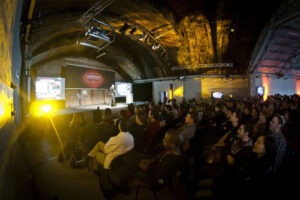It’s become clear to many that Red Hat’s recent missteps with CentOS and the availability of RHEL source code indicate that it’s fallen from its respected place as “the open organization.” SUSE seems to be poised to benefit from Red Hat’s errors. We connect the dots.

Wowie zowie, Batman, German-based SUSE just extended long-term support for Linux Enterprise 15 until July 2037. That’s like 13 years from now (well, actually it is 13 years from now). What’s more, that’s like 19 years after 2018, which is when Linux Enterprise 15 was first released. As SJVN — who’s the only Linux writer to ever be an answer-clue on Jeopardy — proclaimed in a headline over at ZDNET: “no other Linux comes close.”
“SUSE Linux Enterprise Server 15 has a committed lifecycle until 2037,” Sebastian Martinez Torregrosa, principal product marketing manager at SUSE, wrote in a June 16 article when SUSE Linux Enterprise 15 SP6 became available. “With 19 years of support since its release, SUSE provides a safe platform to deploy your long-term applications today, ensuring that your IT investment is safe in the longest term.”
This is one several moves that German-based SUSE has made recently that helps position the company as the new independent enterprise Linux and open source “goto company,” as it becomes ever more obvious that Red Hat is not as independent of IBM as it claims.
These moves aren’t necessarily overreaches on SUSE’s part. It’s been quite a while, but it’s been at the top of the hill before. Up until Novell purchased it in 2004 and ruined the company’s open source cred through a FUD-drenched “most-favored-Linux” deal with Microsoft, the company’s distro was considered by some IT professionals to be Linux’s crown jewel, largely due to YaST which made configuring the system fairly easy.
Computer-focused business-to-business print magazines of the day, which generally ignored Linux releases as a standard practice, covered all new SUSE releases — often even including a review.
For those wondering what SUSE means by “Linux Enterprise,” that’s what the company calls all of its different editions of the Linux operating system. Taken as a whole, all of the company’s OSes grouped together are called “SLE,” for “SUSE Linux Enterprise.” Its server OS, its bread and butter, is “SLES,” for “SUSE Linux Enterprise Server,” and SUSE workstations run on “SLED,” for “SUSE Linux Enterprise Desktop.
All of these flavors from SUSE can now be said to be supported until about five months before the end of time, because in the *Nix world January 19, 2038 is when Linux and many Unix-based systems will count their last second. You don’t need to take my word for it, SJVN explains it here.
SUSE knows something about long periods of time. It’s one of the oldest Linux companies still standing, having been around since 1994, or for about a year before Red Hat. Initially based on Slackware, it was born when Slackware creator and “Benevolent Dictator for Life,” Patrick Volkerding, helped translate Slackware scripts into German, which resulted in the release of the S.u.S.E. Linux 1.0 distribution — and yes, SUSE was weird with capitalization and periods back in the early days.
Taking a Seat at the CentOS Table
Super extended long term support is almost an insignificant tip of the iceberg when considering the innovations coming out of SUSE these days. These innovations are surprising, because since its acquisition by Novell the company has been conservative and slow-to-move. This remained true even after it regained its independence from Micro Focus — its last corporate owner — at about the same time that Red Hat was all but swallowed up by IBM.
The latter might merely have been a reluctance to move too quickly by the company’s new owner, the Swedish investment company EQT AB, but Melissa Di Donato, a button down suit type who became SUSE’s CEO in 2019 shortly after EQT’s involvement, seemed unable, or at least reluctant, to make bold moves.
Her appointment to the position seems to have been motivated by a perceived need to reassure the company’s customer base that no radical changes would be coming to the newly independent company. It also seems relevant that she came to the job directly after spending nearly three years in the C-suite at the business-orientated software company SAP, a company responsible for much if not most of SUSE’s income.
In her favor, the acquisition of the open source Kubernetes startup Rancher happened under her watch, which introduced not only best-of-breed cloud-native technology to the company’s portfolio, but the people acquired in the deal brought with them an innovative spirit the company had been lacking… again, since it was acquired by Novell.

The innovative spirit and loosening-up in SUSE’s internal culture that Rancher brought to the table seems to have been increased with the introduction of Dirk-Peter van Leeuwen, an 18-year Red Hat veteran who replaced Di Donato in March, 2023. While he doesn’t seem to have brought as much of the Red Hat of old’s “open source way” magic to SUSE’s corporate culture as some of us had hoped, he has made important changes in direction that have brought the once ho-hum company plenty of attention.
These changes also have the potential to enable SUSE to take advantage of its newfound position of being the world’s largest independent pure play open source infrastructure company, now that Red Hat resides in IBM’s toolbox. That “world’s largest” status includes arguably better known Canonical, which appears to be about 25% of the size of SUSE according to available financial figures for 2023.
Both companies, of course, are actively seeking to gain traction in areas that are important to enterprise Linux and open source users that Red Hat has abandoned. For SUSE, this includes another move it made during the same week that it supersized SLE’s long-term support, when it cloned CentOS 7 and released it as Liberty Linux Lite, which it will support through June 30, 2028.
This is important to the more than 400,000 users who are estimated to still be running CentOS 7, the downstream RHEL clone that reached its end-of-life on June 30. Although CentOS Linux no longer has an upgrade path, SUSE’s solution allows enterprise users to safely kick the can down the road until they figure out their next move. And since Liberty Linux Lite is a CentOS 7 clone, all IT folks need do is point their CentOS 7 instances to SUSE’s Liberty Lite repositories for patches, once they’ve signed up for support.
For enterprises with a large number of servers, SUSE’s support is dirt cheap, but for smaller operations needing to support fewer machines, not so much. The support contract has a minimum buy-in of $2,500 yearly for 100 servers — $25 per server, which drops to $20 for those running 1,000 or more machines.
Again, that’s an incredibly good deal for operations running lots of servers. For those running fewer than about 60 servers however, less expensive quality support is available for CentOS 7 elsewhere.
Redefining RHEL as ‘Enterprise Linux’
It’s clear that SUSE sees Red Hat’s missteps with CentOS as having created a chink in Red Hat’s armor that it can use to its advantage, and as the largest and best known independent Linux and open source company other than Red Hat, it’s in the position of having the most to gain.
It’s doing that through a combination of moves that include developing its own clone of Red Hat Enterprise Linux, rebranding RHEL by removing Red Hat’s name to produce “Enterprise Linux,” and promoting that code base under that name as a copyleft open source standard — which it is.
For the later, SUSE has not been acting alone. Last August it partnered with Oracle and CIQ, the latter being the startup behind the RHEL clone Rocky Linux. These three companies formed a collaborative trade group, Open Enterprise Linux Association, “to encourage the development of distributions compatible with Red Hat Enterprise Linux by providing open and free Enterprise Linux source code.”
What that means is that OpenELA has developed methods to access RHEL’s open source code, which it makes available to the public for free as Enterprise Linux.
“Collaboration is critical to fostering innovation, which is why we welcome everyone to be part of this association and help us uphold open community standards,” Thomas Di Giacomo, SUSE’s chief technology and product officer said in a statement at the time. “Together with the open source community we will redefine what it truly means to be open and deliver a stronger future for EL.”
On November 2, the newly formed consortium announced it had formed a Technical Steering Committee and had completed the process of incorporating in Delaware as a nonprofit 501(c)(6) organization. What was more important to organizations looking for stability in the RHEL clone arena, the organization said that “the source code for all packages necessary for anyone to build a derivative Enterprise Linux operating system is now available.”
With Oracle not being much liked by many open source users and practitioners because of its mismanagement of MySQL and OpenOffice, open source projects that came under its control after it acquired Sun Microsystems, and with CIQ’s small startup status, this put SUSE in the position to put it’s stamp on some open source cred. Again, it was Di Giacomo who issued the statement:
“We’re pleased to deliver on our promise of making source code available and to continue our work together to provide choice to our customers while we ensure that Enterprise Linux source code remains freely accessible to the public,” he said. “We’ve seen tremendous involvement and interest from the community in OpenELA, which demonstrates just how important it is to the open source community that we as an ecosystem remain open and work together to deliver accessible solutions for all.”
Establishing SUSE as an Innovator With ALP
SUSE has also been busy developing a server-grade immutable Linux distribution, which is a security-focused distribution in which the operating system is read-only, with software being installed using some sort of sandboxed containerized scheme such as Snap or Flatpak with limited privileges, or using actual Docker style containers.
This isn’t much of a surprise, since everybody from Red Hat to Ubuntu are doing the same, primarily to be used for deployments where updates are difficult if not all but impossible — say for connected IoT devices or other edge uses — or for the base operating system within Kubernetes containers. In fact, SUSE has been offering one of these for years, called SLE Micro.
The immutable system its developing now is different, as it appears that the company plans for it to eventually be a super secure and relatively easy-to-use replacement for SLES. It’s called ALP, for Adaptable Linux Platform, and it’s being designed to be easy-to-maintain and versatile enough to be deployed on-premises, in cololocation data centers, in the cloud, or somewhere on the edge. It’s focused on cloud-native style deployments, and SUSE has been clear that they expect it to go mainstream.
The company has also been busy for a while readying the market to accept it once it’s released. Since 2022, it’s been releasing an installable “prototype” of the not-ready-for-prime-time operating system every three months. When the third prototype was released in April of 2023, Marco Varlese, director of engineering for SUSE’s Linux Systems Engineering described the platform in a blog post on SUSE’s website:
“ALP stands for SUSE’s Adaptable Linux Platform, providing a new approach to enterprise Linux for evolving use cases in a cloud-native world — from core to cloud to edge,” he said. “ALP is an application-centric, secure, and flexible platform designed to focus on workloads while abstracting from the hardware and the application runtime layers.”
In December, something of a marketing post on SUSE’s website from Sergio Ocón-Cárdenas, the project lead for SUSE Linux Framework One, went into a degree of detail about ALP that also explained how it differs from traditional Linux operating systems, which he points out have been on the same evolutionary path for 30 years or so. He finished with this sales pitch:
“Some required parts are available today and have been in production for years (like SLE Micro), but SUSE has gone a step beyond a comprehensive solution for the data center,” he wrote. “This all-encompassing solution includes the OS and the essential tools for constructing and executing certified containers within the OS framework.
“Engineered to function as the inconspicuous OS, it’s designed to be effortlessly manageable, user-friendly, and deployable. This new platform seamlessly integrates familiar Linux server components that you expect to have available, such as the dhcpd daemon or the Apache http server. Our mission is to offer a platform that embodies both support and agility simultaneously. We aim to deliver the components you need. Allowing you to customize your version. So you can concentrate on revenue generation while entrusting SUSE with the security and support of the underlying OS.”
It’s pretty obvious to me that much like Microsoft and Amazon Web Services are doubling down on generative AI, SUSE is betting big that a full featured and highly secure immutable operating system that’s designed to be cloud-native and easy-to-use from the bottom up will be its ticket to be the open source and Linux-based solutions provider for late 2020s and beyond that Red Hat was during the aughts and 2010s.
Christine Hall has been a journalist since 1971. In 2001, she began writing a weekly consumer computer column and started covering Linux and FOSS in 2002 after making the switch to GNU/Linux. Follow her on Twitter: @BrideOfLinux











Very good SUSE!
This is exactly what we need. SUSE is going to right direction -again!
And remember, SUSE is also an European choise!!
Thank you guys on development and more!
First, SuSE is going on a very dangerous path cuttting off it’s community upstream openSuSE by asking them to rebrand.
Second, under SUSE weird management style, almost all new employees, acquired with the rancher acquisition, have left the company.
Finally, and unfortunately, SuSE falls short of the potential they could have had.
My first thought at seeing Liberty Linux described as a CentOS clone again was how unbelievable it is that journalists who specialize in this still haven’t read SUSE’s announcement 2.5 years later, which clearly states it’s a support offering, not a new distro.
Then I discovered that YOU wrote an article a few weeks after the LL launch taking other journalists to task for misreporting the nature of the product, and rightly so.
How is it that you did that and now you’re reporting it’s a CentOS clone again in this article?
YAST is trash, Suse is the neighborhood bicycle.